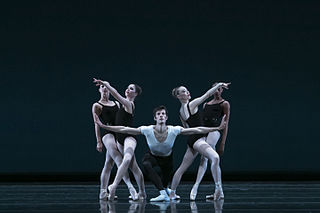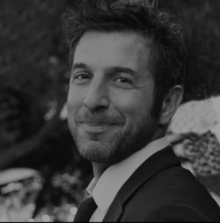
George Balanchine was a Georgian-American ballet choreographer, recognized as one of the most influential choreographers of the 20th-century. Styled as the father of American ballet, he co-founded the New York City Ballet and remained its artistic director for more than 35 years. His choreography is characterized by plotless ballets with minimal costume and décor, performed to classical and neoclassical music.

Mikhail Nikolayevich Baryshnikov is a Latvian-American dancer, choreographer, and actor. He was the preeminent male classical ballet dancer of the 1970s and 1980s. He subsequently became a noted dance director.

New York City Ballet (NYCB) is a ballet company founded in 1948 by choreographer George Balanchine and Lincoln Kirstein. Balanchine and Jerome Robbins are considered the founding choreographers of the company. Léon Barzin was the company's first music director. City Ballet grew out of earlier troupes: the Producing Company of the School of American Ballet, 1934; the American Ballet, 1935, and Ballet Caravan, 1936, which merged into American Ballet Caravan, 1941; and directly from the Ballet Society, 1946.
Philadelphia Ballet is the largest ballet company in Philadelphia. The company's annual local season features six programs of classic pieces, such as George Balanchine's The Nutcracker, in addition to presentations of new works. The company's artistic director is Angel Corella.

Tchaikovsky Pas de Deux is a ballet choreographed by George Balanchine to a composition by Pyotr Ilyich Tchaikovsky originally intended for act 3 of Swan Lake. With costumes by Barbara Karinska and lighting by Jack Owen Brown, it was first presented by New York City Ballet at the City Center of Music and Drama, New York, on 29 March 1960. Robert Irving conducted the New York City Ballet Orchestra. The dancers were Violette Verdy and Conrad Ludlow.

Episodes is a ballet choreographed by Martha Graham and George Balanchine, to compositions by Anton Webern. The ballet was a co-production between the Martha Graham Dance Company and Balanchine's New York City Ballet (NYCB). Though it was conceived to be a collaboration between Graham and Balanchine, leading choreographers in modern dance and neoclassical ballet respectively, they ultimately worked separately on the ballet's two halves. Episodes I was choreographed by Graham, for dancers from her company and four NYCB members, and depicts Mary, Queen of Scots remembering the events in her life before her execution. Episodes II, by Balanchine, is completely plotless, and made for members of the NYCB and Graham dancer Paul Taylor, who originated a solo. The ballet uses all seven orchestral compositions by Webern.

Ballet is a formalized dance form with its origins in the Italian Renaissance courts of 15th and 16th centuries. Ballet spread from Italy to France with the help of Catherine de' Medici, where ballet developed even further under her aristocratic influence. An early example of Catherine's development of ballet is through 'Le Paradis d' Amour', a piece of work presented at the wedding of her daughter Marguerite de Valois to Henry of Navarre. Aristocratic money was responsible for the initial stages of development in 'court ballet', as it was royal money that dictated the ideas, literature and music used in ballets that were created to primarily entertain the aristocrats of the time. The first formal 'court ballet' ever recognized was staged in 1573, 'Ballet des Polonais'. In true form of royal entertainment, 'Ballet des Polonais' was commissioned by Catherine de' Medici to honor the Polish ambassadors who were visiting Paris upon the accession of Henry of Anjou to the throne of Poland. In 1581, Catherine de' Medici commissioned another court ballet, Ballet Comique de la Reine, however it was her compatriot, Balthasar de Beaujoyeulx, who organized the ballet. Catherine de' Medici and Balthasar de Beaujoyeulx were responsible for presenting the first court ballet ever to apply the principles of Baif's Academie, by integrating poetry, dance, music and set design to convey a unified dramatic storyline. Moreover, the early organization and development of 'court ballet' was funded by, influenced by and produced by the aristocrats of the time, fulfilling both their personal entertainment and political propaganda needs.
Troy Schumacher is an American choreographer, dancer, and director based in New York City. He is a soloist in the New York City Ballet and has choreographed for the company since 2014; before being promoted to soloist, he danced in NYCB's corps de ballet starting in 2005. He is the founder of Balletcollective, an arts collective that has created new ballet-based works since its inception in 2010. His work has been presented by New York City Ballet, Martha Graham Dance Company, The Metropolitan Museum of Art, Lincoln Center's Mostly Mozart Festival, Performa, Danspace Project, Guggenheim Works & Process, the Joyce Theater, and NYU Skirball Center. In addition to live performances, Schumacher has choreographed numerous fashion and commercial shoots, including works for Sony PlayStation, Capezio featuring Maddie Ziegler, HP, Aritzia, CR Fashion Book, Tom Ford, and The New York Times. He has been dubbed a “visionary artist” by T Magazine and is “one of his generation’s most acclaimed choreographers”
Orpheus is a thirty-minute neoclassical ballet in three tableaux composed by Igor Stravinsky in collaboration with choreographer George Balanchine in Hollywood, California in 1947. The work was commissioned by the Ballet Society, which Balanchine founded together with Lincoln Kirstein and of which he was Artistic Director. Sets and costumes were created by Isamu Noguchi.
Tschaikovsky Piano Concerto No. 2, also titled Ballet Imperial, is a ballet choreographed by George Balanchine to Tchaikovsky's Piano Concerto No. 2. Ballet Imperial was choreographed for American Ballet Caravan's 1941 South American tour, and was aimed at showing that the Americans were capable of the classical ballet traditions. The ballet pays tribute to Tchaikovsky, the classical ballet choreographer Marius Petipa, and Imperial Saint Petersburg, where Balanchine received his ballet training. The ballet featured academic steps and alludes to Imperial Russia through the costumes and scenery. Ballet Imperial premiered on June 25, 1941, at Teatro Municipal, Rio de Janeiro.
Fanfare is a one-act ballet choreographed by Jerome Robbins to Benjamin Britten's The Young Person's Guide to the Orchestra, in celebration of the Coronation of Queen Elizabeth II. The ballet premiered on June 2, 1953, the night of the coronation, at the City Center of Music and Drama, danced by the New York City Ballet.
Mozartiana is a ballet choreographed by George Balanchine to Tchaikovsky's Orchestral Suite No. 4, Mozartiana. The current version of the ballet was made for New York City Ballet's Tchaikovsky Festival, and premiered on June 4, 1981, at the New York State Theater. It is considered Balanchine's last major work.
Raymonda Variations, formerly titled Valses et Variations, is a ballet choreographed by George Balanchine to excepts from Alexander Glazunov's score for the 1898 ballet Raymonda. Instead of following the plot of the 1898 ballet, the Balanchine ballet is plotless. It premiered on December 7, 1961, at the City Center of Music and Drama. Raymonda Variations was made for the New York City Ballet, with the two lead roles originated by Patricia Wilde and Jacques d'Amboise.

The Four Temperaments or Theme and Four Variations is an orchestral work and ballet by Paul Hindemith. Although it was originally conceived as a ballet for Léonide Massine, the score was ultimately completed as a commission for George Balanchine, who subsequently choreographed it as a neoclassical ballet based on the theory of the four temperaments.
Alfonso Catá was a Cuban ballet dancer, choreographer, teacher, and company director, active in the United States, Switzerland, Germany, and France.

Silas Farley is an American ballet dancer, choreographer and educator. He danced at the New York City Ballet between 2013 and 2020, and choreographed outside the company. Between 2021 and 2023, he was the dean of Colburn School's Trudl Zipper Dance Institute.
Judith Chazin-Bennahum is a ballet dancer, choreographer, dance historian, writer, and educator. A leader in the field of dance scholarship, she spent her academic career at the University of New Mexico, where she now holds the title of Distinguished Professor Emerita of Dance.
Balanchine technique or Balanchine method is the ballet performance style invented by dancer, choreographer, and teacher George Balanchine (1904–1983), and a trademark of the George Balanchine Foundation. It is used widely today in many of Balanchine's choreographic works. It is employed by ballet companies and taught in schools throughout North America, including the New York City Ballet and School of American Ballet, where it first emerged.
The Commanders was an upcoming American anthology drama series was set to premiere on History.
Divertimento No. 15 is a ballet choreographed by George Balanchine to Mozart's eponymous music. The ballet was made for the New York City Ballet. Balanchine first choreographed the score in 1952, for a ballet titled Caracole. In 1956, he planned to revive Caracole for a celebration of Mozart's bicentenary but made a new ballet to the same music instead. Divertimento No. 15 premiered on May 31, 1956, at the American Shakespeare Theatre, Stratford, Connecticut.








